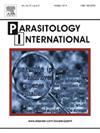Exploring the impacts of El Niño-Southern Oscillation (ENSO) and North Atlantic Oscillation (NAO) on the spatial distribution of Fasciola spp. in the Gilan province, Iran
IF 1.9
4区 医学
Q3 PARASITOLOGY
引用次数: 0
Abstract
This study investigated the correlation between large-scale climate phenomena, particularly El Niño-Southern Oscillation (ENSO) and North Atlantic Oscillation (NAO), and the distribution of Fasciola species in Gilan province, Iran. Climate change significantly impacts animal health, particularly through vector-borne diseases. Fasciola spp. is highly sensitive to temperature and soil moisture conditions, making its relationship with climate complex and influenced by various meteorological variables. ENSO and NAO index data were obtained from National Oceanic and Atmospheric Administration (NOAA). Local meteorological data from 4 Gilan stations and Fasciola spp. distribution data were collected for 20-year period. Correlation analysis between climate factors and Fasciola spp. distribution was performed, considering time lags at 95 % confidence level. Results showed a significant relationship (p-value <0.05) between monthly precipitation, ENSO indices (Southern Oscillation Index, Oceanic Niño Index, Multivariate ENSO Index), and the NAO index with varying time lags. Fasciola spp. distribution in livestock demonstrated significant correlations with the SOI index (negative correlation) and the ONI index (positive correlation), as well as strong negative correlations with average monthly temperature, soil temperature, and wet temperature. In conclusion, the distribution of Fasciola species based on the ONI index, was generally higher in years with El Niño events than in years with La Niña events. El Niño's increased rainfall creates ideal conditions for intermediate host snails, facilitating Fasciola spp. transmission. Conversely, La Niña's drier conditions restrict intermediate host survival, decreasing Fasciola spp. distribution. These findings enhance understanding of Fasciola species transmission dynamics in Gilan, aiding development of climate-responsive control strategies.

El Niño-Southern涛动(ENSO)和北大西洋涛动(NAO)对伊朗吉兰地区片形吸虫空间分布的影响
研究了伊朗吉兰地区大尺度气候现象,特别是厄尔尼诺Niño-Southern涛动(ENSO)和北大西洋涛动(NAO)与片形虫分布的相关性。气候变化严重影响动物健康,特别是通过病媒传播的疾病。片形吸虫对温度和土壤湿度条件高度敏感,与气候的关系复杂,受多种气象变量的影响。ENSO和NAO指数数据来自美国国家海洋和大气管理局(NOAA)。收集了吉兰4个站点20年的气象资料和片形吸虫分布资料。考虑时间滞后,在95% %置信水平上对气候因子与片形吸虫分布进行相关性分析。结果显示显著相关(p值)
本文章由计算机程序翻译,如有差异,请以英文原文为准。
求助全文
约1分钟内获得全文
求助全文
来源期刊

Parasitology International
医学-寄生虫学
CiteScore
4.00
自引率
10.50%
发文量
140
审稿时长
61 days
期刊介绍:
Parasitology International provides a medium for rapid, carefully reviewed publications in the field of human and animal parasitology. Original papers, rapid communications, and original case reports from all geographical areas and covering all parasitological disciplines, including structure, immunology, cell biology, biochemistry, molecular biology, and systematics, may be submitted. Reviews on recent developments are invited regularly, but suggestions in this respect are welcome. Letters to the Editor commenting on any aspect of the Journal are also welcome.
 求助内容:
求助内容: 应助结果提醒方式:
应助结果提醒方式:


